Aiwa XR-M55 User Manual
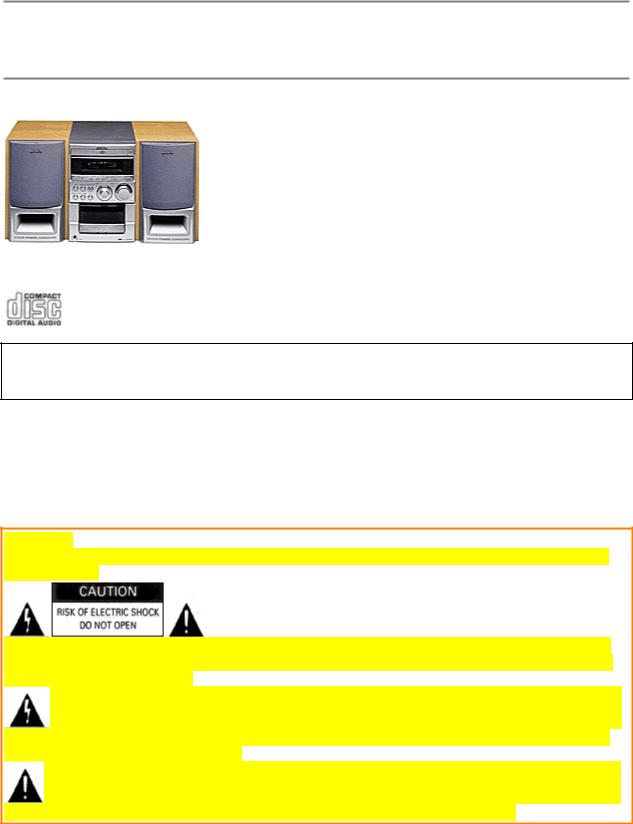
AIWA
COMPACT DISC STEREO SYSTEM
XR-M55
OPERATING INSTRUCTIONS
For assistance and information,
call toll free 1-800-BUY-AIWA.
(United States and Puerto Rico)
8Z-CL6-901-01 981110AWW-X6
|
|
|
|
|
ENGLISH |
pg. 1 |
|
|
|
|
|
WARNING
TO REDUCE THE RISK OF FIRE OR ELECTRIC SHOCK, DO NOT EXPOSE THIS APPLIANCE TO RAIN OR MOISTURE.
"CAUTION : TO REDUCE THE RISK OF ELECTRICAL SHOCK, DO NOT REMOVE COVER (OR BACK). NO USER-SERVICEABLE PARTS INSIDE. REFER SERVICING TO QUALIFIED SERVICE PERSONNEL." Explanation of Graphical Symbols:
The lightning flash with arrowhead symbol, within an equilateral triangle, is intended to alert the user to the presence of uninsulated "dangerous voltage" within the product's enclosure that may be of sufficient magnitude to constitute a risk of electric shock to persons.
The exclamation point within an equilateral triangle is intended to alert the user to the presence of important operating and maintenance (servicing) instructions in the literature accompanying the appliance.

PRECAUTIONS
Read the Operating Instructions carefully and completely before operating the unit. Be sure to keep the Operating Instructions for future reference. All warnings and cautions in the Operating Instructions and on the unit should be strictly followed, as well as the safety suggestions below.
Installation
1 Water and moisture - Do not use this unit near water, such as near a bathtub, washbowl, kitchen sing, laundry tub, in a wet basement, swimming pool, or the like.
2 Heat - Do not use this unit near sources of heat, including heating vents, stoves, or other appliances that generate heat.
It also should not be placed in temperatures less than 5*C (41*F) or greater than 35*C (95*F). 3 Mounting surface - Place the unit on a flat, even surface.
4 Ventilation - The unit should be situated with adequate space around it so that proper heat ventilation is assured. Allow 10 cm (4 in.) clearance form the rear an the top of the unit and 5 cm (2 in.) from each side.
-Do not place the unit on a bed, rug, or similar surface that may block the ventilation openings.
-Do not install the unit in a bookcase, cabinet, or airtight rack where ventilation may be impeded.
5 Objects and liquid entry - Take care that objects or liquids do not get inside the unit through the ventilation openings.
6 Carts and stands- When placed or mounted on a stand or cart, the unit should be moved with care. Quick stops, excessive force, and uneven surfaces may cause the unit or cart to overturn or fall.
7 Condensation - Moisture may form on the CD pickup lens when:
-the unit is moved from a cold spot to a warm spot
-the heating system has just been turned on
-the unit is used in a very humid room
-the unit is cooled by an air conditioner
When this unit has condensation inside, it may not function normally. Should this occur, leave the unit for a few hours, then try to operate again.
8 Wall or ceiling mounting - The unit should not be mounted on a wall or ceiling, unless specified in the operating instructions.
Electric Power
1 Power sources - Connect this unit only to power sources specified in the Operating Instructions, and as marked on the unit.
2 Polarization - As a safety feature, some units are equipped with polarized AC power plugs which can only be inserted one way into a power outlet. If it is difficult or impossible to insert the AC power plug into an outlet, turn the plug over and try again. If it still does not easily insert into the outlet, please call a qualified service technician to service or replace the outlet. To avoid defeating the safety feature of the polarized plug, do not force it into a power outlet.
3 AC power cord
-When disconnecting the AC power cord, pull it out by the AC power plug. Do not pull the cord itself.
-Never handle the AC power plug with wet hands, as this could result in fire or shock.
Do not walk on the power cord or pinch it by items placed upon or against it, as these could result in fire or shock. - Avoid overloading AC power plugs and extension cords beyond their capacity, as this could result in fire or shock.
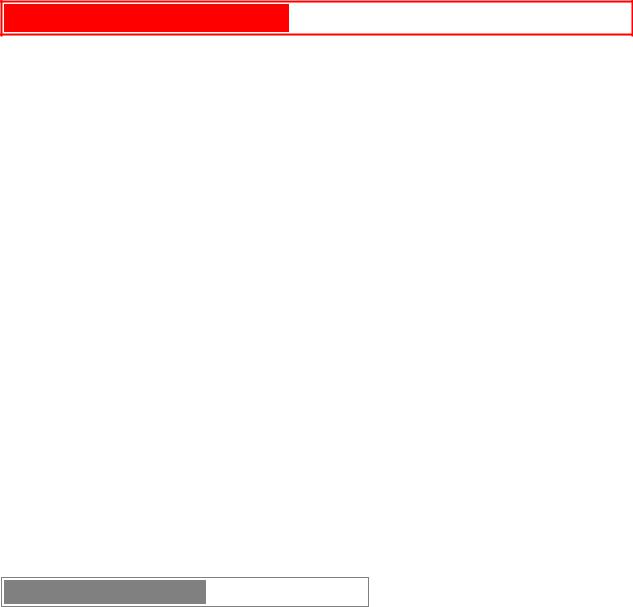
PRECAUTIONS (cont) pg. 2
4 Extension cord - To help prevent electric shock, do not use a polarized AC power plug with an extension cord, receptacle, or other outlet unless the polarized plug can be completely inserted to prevent exposure of the blades of the plug.
5 Nonuse periods - Unplug the AC power cord from the AC power plug if the unit will not be used for several months or more. When the cord is plugged in, a small amount of current continues to flow to the unit, even when the power is turned off.
Outdoor Antenna
1 Power lines- When connecting an outdoor antenna, make sure it is located away from power lines.
2 Outdoor antenna grounding- Be sure the antenna system is properly grounded to provide protection against unexpected voltage surges or static electricity build-up. Article 810 of the National Electric Code, ANSI/NFPA70, provides information on proper grounding of the mast, supporting structure, and the lead-in wire to the antenna discharge unit, as well as the size of the grounding unit, connection to grounding terminals, and requirements for grounding terminals themselves.Maintenance
Clean the unit only as recommended in the Operating Instructions.
Damage Requiring Service
Have the units serviced by a qualified service technician if:
-The AC power cord or plug has been damaged
-Objects or liquid have gotten inside the unit
-The unit has been exposed to rain or water
-The unit does not seem to operate normally
-The unit exhibits a marked change in performance
-The unit has been dropped, or the cabinet has been damaged DO NOT ATTEMPT TO SERVICE THE UNIT YOURSELF
Owner's record
For your convenience,record the model number and serial number (you will find them on the rear of your set) in the space provided below. Please refer to them when you contact your Aiwa dealer in case of difficulty.
Model No. |
Serial No. (Lot No.) |
XR-M55 U |
|
TABLE OF CONTENTS
PRECAUTIONS . . . . . . . . . . . . . . . . . . . . . . . . . . . . . . . . . . . . . . . . . . . . . . . . . . . . . . 1
PREPARATIONS
CONNECTIONS . . . . . . . . . . . . . . . . . . . . . . . . . . . . . . . . . . . . . . . . . . . . . . . . . . . . . 3 REMOTE CONTROL. . . . . . . . . . . . . . . . . . . . . . . . . . . . . . . . . . . . . . . . . . . . . . . . . . 5 BEFORE OPERATION . . . . . . . . . . . . . . . . . . . . . . . . . . . . . . . . . . . . . . . . . . . . . . . .5
SOUND
AUDIO ADJUSTMENTS . . . . . . . . . . . . . . . . . . . . . . . . . . . . . . . . . . . . . . . . . . . . . . 7 GRAPHIC EQUALIZER. . . . . . . . . . . . . . . . . . . . . . . . . . . . . . . . . . . . . . . . . . . . . . . . 7
RADIO RECEPTION
MANUAL TUNING . . . . . . . . . . . . . . . . . . . . . . . . . . . . . . . . . . . . . . . . . . . . . . . . . . . 8 PRESETTING STATIONS . . . . . . . . . . . . . . . . . . . . . . . . . . . . . . . . . . . . . . . . . . . . . 8
CD PLAYING
BASIC OPERATIONS . . . . . . . . . . . . . . . . . . . . . . . . . . . . . . . . . . . . . . . . . . . . . . . . .9 PROGRAMMED PLAY. . . . . . . . . . . . . . . . . . . . . . . . . . . . . . . . . . . . . . . . . . . . . . . .10
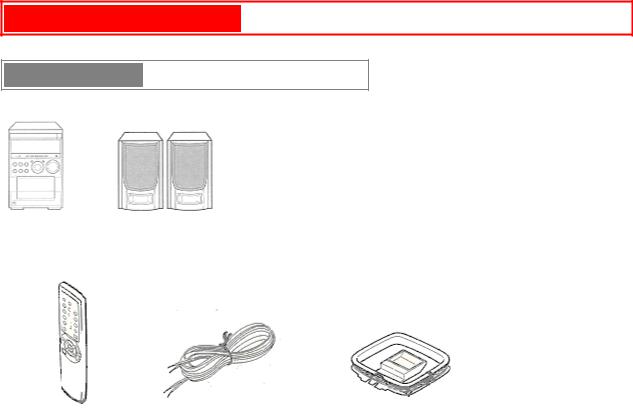
TAPE PLAYBACK
BASIC OPERATIONS . . . . . . . . . . . . . . . . . . . . . . . . . . . . . . . . . . . . . . . . . . . . . . . .11
RECORDING
BASIC RECORDING . . . . . . . . . . . . . . . . . . . . . . . . . . . . . . . . . . . . . . . . . . . . . . . . .12 AI EDIT RECORDING . . . . . . . . . . . . . . . . . . . . . . . . . . . . . . . . . . . . . . . . . . . . . . . 13 PROGRAMMED EDIT RECORDING . . . . . . . . . . . . . . . . . . . . . . . . . . . . . . . . . . . 14
CLOCK AND TIMER
SETTING THE CLOCK. . . . . . . . . . . . . . . . . . . . . . . . . . . . . . . . . . . . . . . . . . . . . . . .15 SETTING THE SLEEP TIMER . . . . . . . . . . . . . . . . . . . . . . . . . . . . . . . . . . . . . . . . . 15 SETTING THE TIMER . . . . . . . . . . . . . . . . . . . . . . . . . . . . . . . . . . . . . . . . . . . . . . .16
OTHER CONNECTIONS
CONNECTING OPTIONAL EQUIPMENT . . . . . . . . . . . . . . . . . . . . . . . . . . . . . . .17 LISTENING TO EXTERNAL SOURCES . . . . . . . . . . . . . . . . . . . . . . . . . . . . . . . . .17
GENERAL
CARE AND MAINTENANCE . . . . . . . . . . . . . . . . . . . . . . . . . . . . . . . . . . . . . . . . . 18 TROUBLESHOOTING GUIDE . . . . . . . . . . . . . . . . . . . . . . . . . . . . . . . . . . . . . . . . 18 SPECIFICATIONS . . . . . . . . . . . . . . . . . . . . . . . . . . . . . . . . . . . . . . . . . . . . . . . . . . . 19 PARTS INDEX. . . . . . . . . . . . . . . . . . . . . . . . . . . . . . . . . . . . . . . . . . . . . . . . . . . . . . .20
PREPARATIONS  pg. 3
pg. 3
CONNECTIONS
Check your system accessories
XR-M55 |
Speakers (L,R) |
Compact disc |
|
stereo cassette receiver |
|
Remote control |
FM antenna |
AM antenna |
Operating Instructions, etc.
Before connecting the AC cord
The rated voltage of your unit shown on the rear panel is 120 V AC. Check that the rated voltage matches your local voltage.
IMPORTANT
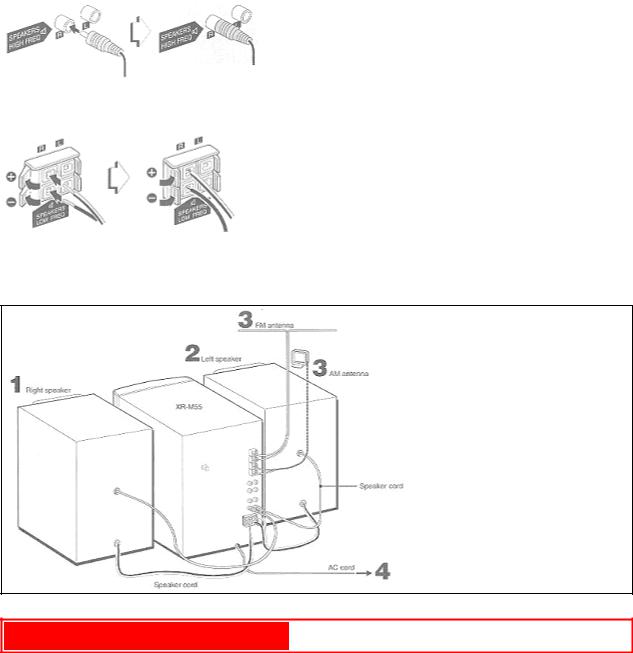
•Connect the speakers, antennas, and all optional equipment first. Then connect the AC cord in the end.
•There are no differences between the front speakers. Both speakers can be connected as L (left) or R (right)
1 Connect the right speaker to the main unit.
(1) Connect the speaker cord with the plug to the SPEAKERS HIGH FREQ R terminal.
(2) Connect the speaker cord with the white stripe to the SPEAKERS LOW FREQ R + terminal and the black cord to the - terminal.
2 Connect the left speaker to the main unit.
Connect the speaker cord with plug to the SPEAKERS HIGH FREQ L terminal, and another speaker cord to the SPEAKERS LOW FREQ L terminals in the same manner as step 1.
PREPARATIONS (cont) pg. 4
3 Connect the supplied antennas.
Connect the FM antenna to FM 75 Ω terminals and the AM antenna to AM LOOP terminals.
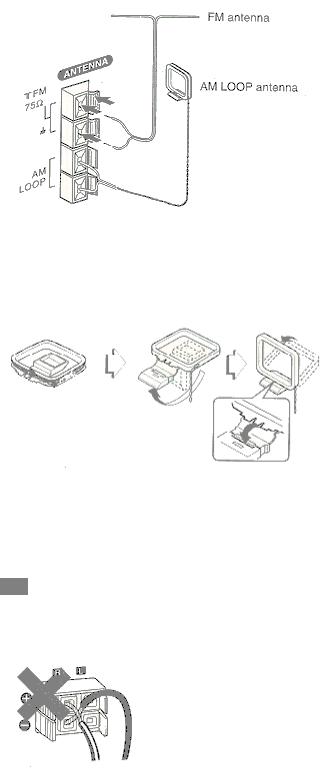
4 Connect the AC cord to an AC outlet.
To stand the AM loop antenna on a surface
Fix the claw to the slot.
To position the antennas
FM feeder antenna:
Extend this antenna horizontally in a T-shape and fix its ends to the wall.
AM loop antenna:
Position for the best reception.
Note
•Do not connect any speakers to the unit other than the supplied ones.
•Be sure to connect the speaker cor ds correctly. Improper connections can cause short circuits in SPEAKERS terminals.
•Do not leave objects generating magnetism, such as credit cards, near the speakers, as these objects may be damaged.
•Do not bring the FM antenna near metal objects or curtain rails.
•Do not bring the AM antenna near other optional equipment, the stereo system itself, the AC cord or speaker cords, since noise will be picked up.
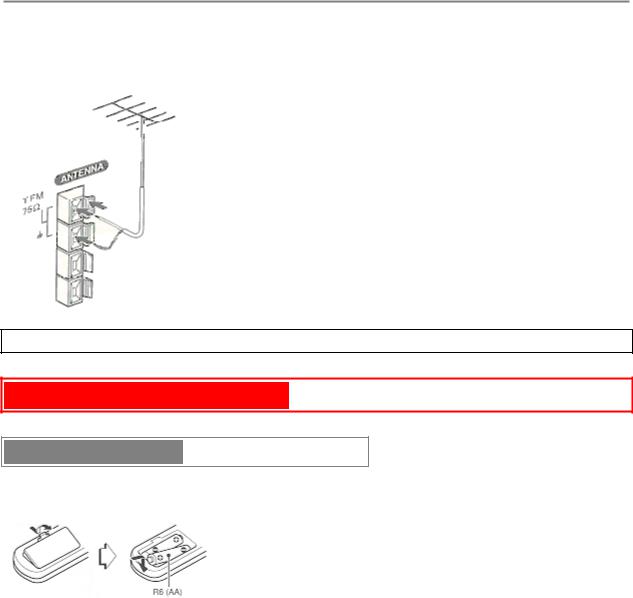
• Do not unwind the AM antenna wire.
CONNECTING AN OUTDOOR ANTENNA
For better FM reception, use of an outdoor antenna is recommended.
Connect the outdoor antenna to FM 75 Ω terminals.
To connect other optional equipment --> page 17
PREPARATIONS (cont) pg. 5
REMOTE CONTROL
Inserting batteries
Detach the battery cover on the rear of the remote control and insert two size AA (R6) batteries.
When to replace the batteries
The maximum operational distance between the remote control and the sensor on the main unit should be approximately 5 meters (16 feet). When this distance decreases, replace the batteries with new ones.
Using the remote control
The instructions in this manual refer mainly to the buttons on the main unit. Buttons on the remote control with the same names as those on the main unit can be used as well.
To use FUNCTION on the remote control
The FUNCTION substitutes for the function buttons (TAPE, TUNER, VIDEO/AUX, CD, MD) on the main unit. Each time FUNCTION is pressed while power is on, the next function is selected cyclically.
 PLAY on the remote control
PLAY on the remote control
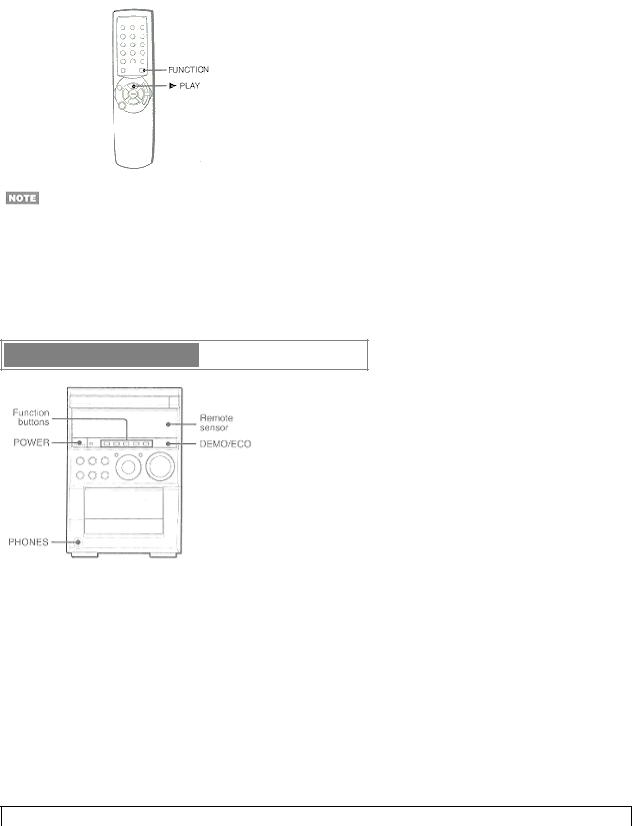
The function is the same as that of  on the main unit.
on the main unit.
•If the remote control is not going to be used for an extended period of time, remove the batteries to prevent possible electrolyte leakage.
•The r emote control may not operate correctly when:
-The line of sight between the remote control and the remote sensor above DEMO/ECO is exposed to intense light, such as direct sunlight
-Other remote controls are used nearby (those of a television, etc.)
BEFORE OPERATION
To turn the unit on
Press one of the function buttons (TAPE, TUNER, VIDEO/AUX, CD, MD). Playback of the inserted disc or tape begins, or the previously tuned station is received (Direct Play Function).
POWER is also available.
To turn the power off
Press POWER. When the clock is set, the unit will return to the ECO mode or clock display depending on the setting before you turn on the unit.
If the previous setting is DEMO, the unit will also return to the clock display.
• If the clock is not set, the unit will always return to the DEMO mode.
DEMO (Demonstration) mode
When the AC cord is connected, the display window demonstrates the functions of the unit. When the power is turned on, the DEMO display is overridden by the operation display.
To cancel (Demonstration) mode
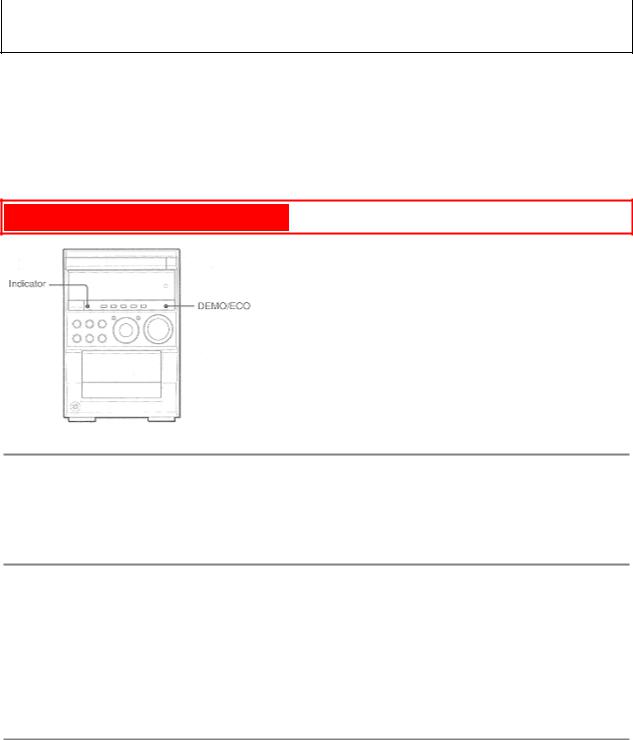
Press DEMO/ECO.
To re-activate the DEMO mode, press DEMO/ECO until the display window demonstrates the functions of the unit.
To change the brightness of the display
Press DEMO/ECO twice during power on.
The display is dimmer than usual, press DEMO/ECO again to restore normal display.
Using the headphones
Connect the headphones to PHONES jack with a stereo mini plug (ø3.5 mm, 1/8 inch).
No sound is output from the speakers while the headphones are plugged in.
PREPARATIONS (cont) pg. 6
SETTING ECO (POWER ECONOMIZING) MODE
Setting this unit to power economizing mode reduces power consumption.
Press DEMO/ECO repeatedly (during power off) until "ECO MODE" is displayed.
The display disappears and the indicator beside the POWER lights up.
4-Channel Multi-Amplifier System
To provide reinforcement for the ultra-low frequencies, in addition to the Left/Right 2-channel amplifier used to reproduce mid-to-high-range frequencies (200Hz - 20 kHz), this system incorporates a second L/R 2-channel amplifier just for reproduction of ultra-low frequencies - making it, in effect, a 4-amplifier system. By utilizing discrete amplifiers for mid-to-high-frequencies and low frequencies, high quality sonic reproduction that is virtually free from distortion can be realized.
This Multi Amplifier System, which utilizes independent circuitry for the different frequency ranges, enables superb sonic reproduction free from distortion.
Built-in Subwoofer System
The built-in subwoofer System has a separate subwoofer cavity area that is part of the loudspeaker cabinet structure, which acts as a sonic filter to cut distortion components. (In the Multi Amplifier System, the ultra-low frequency signals transmitted from their own independent amplifier are reproduced in this area.) This separate construction gives a clear, rich definition to bass reproduction and it can realize clear, well-defined mid-to-high frequency signals. And AIWA's built-in subwoofer system incorporates a subwoofer capable of powerful, satisfying bass performance
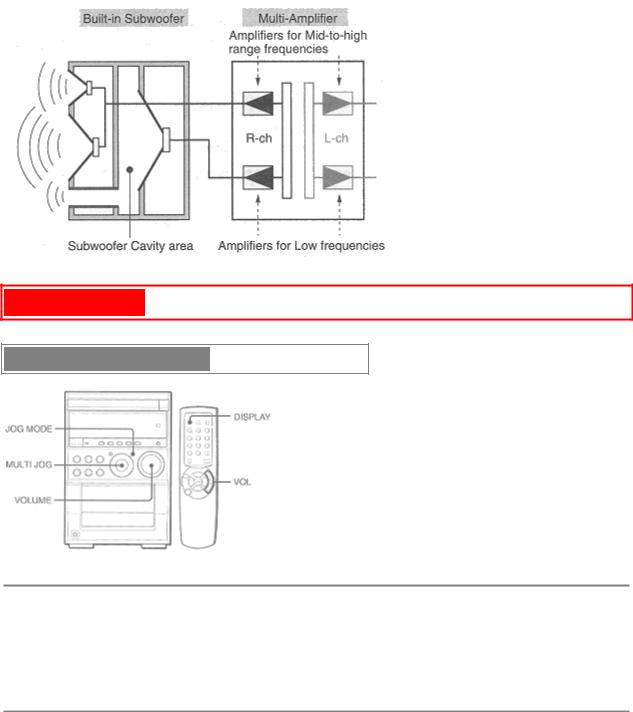
with true stereo separation.
SOUND pg. 7
AUDIO ADJUSTMENTS
VOLUME
Turn VOLUME/MULTI JOG on the main unit, or press VOL ( /\ or \/ ) on the remote control.
The volume level is displayed as a number from 0 to MAX (31).
The volume level is automatically set to 20 when the power is turned off with the volume level set to 21 or more. To see the present volume level press DISPLAY on the remote control twice.
SUPER T-BASS SYSTEM
The T-BASS system enhances the realism of low-frequency sound.
Press JOG MODE once, then turn MULTI JOG within 3 seconds to change the T-Bass level.
The level changes as follows. Select one of the three levels or the off position to suit your preference
T - BASS 0 ↔ T - BASS 1 ↔ T - BASS 2 ↔ T - BASS 3
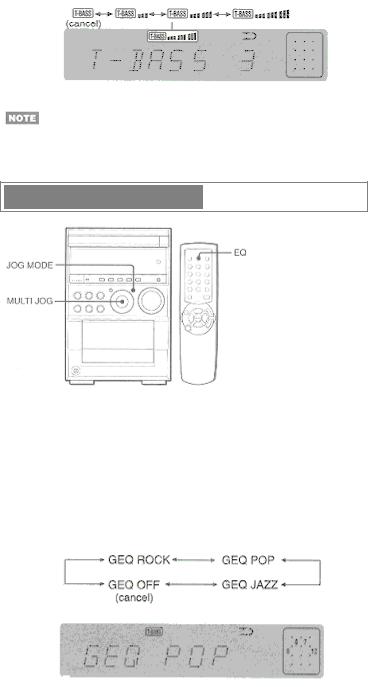
(off)
Low frequency sound maybe distorted when the T-BASS system is used for a disc or tape in which low frequency sound is originally emphasized. In this case, cancel the T-BASS system.
GRAPHIC EQUALIZER
This unit provides the following three different equalization curves.
ROCK: Powerful sound emphasizing treble and bass
POP: More presence in the vocals and midrange
JAZZ: Accented lower frequencies for jazz-type music
Press JOG MODE repeatedly until "GEQ" is displayed, then turn MULTI JOG within 3 seconds to select an equalization curve.
The equalization mode is displayed. as follows:
To cancel the selected mode
Press JOG MODE repeatedly until "GEQ" is displayed, then turn MULTI JOG within 3 seconds until GEQ OFF" is displayed.
To select with the remote control
Press EQ repeatedly. The GEQ mode is displayed cyclically as follows.
